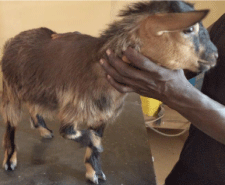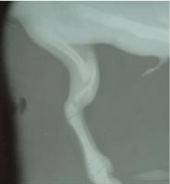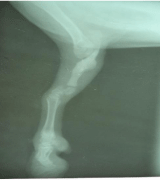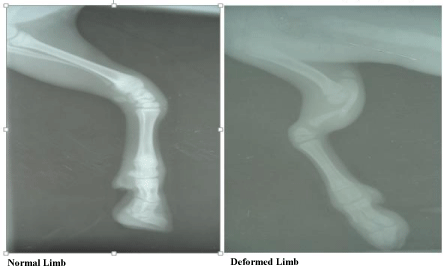
Special Article - Radiology Case Reports
Austin J Radiol. 2017; 4(1): 1062.
Radiographic Finding of Radial Hemimelia in a 6-Day- Old West African Dwarf Goat with a Fractured Ulna
Oviawe EI¹*, Yakubu AS¹, Kene ROC¹, Buhari S¹ and Mayaki AM²
¹Departement of Surgery and Radiology, Usmanu Danfodiyo University, Nigeria
²Department of Veterinary Medicine, Usmanu Danfodiyo University, Nigeria
*Corresponding author: Oviawe EI, Departement of Surgery and Radiology, Usmanu Danfodiyo University, Sokoto, Nigeria
Received: December 26, 2016; Accepted: February 14, 2017; Published: February 24, 2017
Abstract
This report describes a case of radial hemimelia in a 6 day-old West African Dwarf female kid presented at the Large Animal Clinic of Veterinary Teaching Hospital, Usmanu Danfodiyo University, Sokoto, Nigeria, because of inability to bear weight as a result of suspected bone fracture of the right forelimb which was noticed few minutes after kidding. Physical examination revealed crepitation along the ulna shaft of the right forelimb. Radiographic examination revealed complete absence of the radius, malformed carpal bones, reduced congruity at the humeroulna joint, and curved ulnar bone with a complete closed transverse fracture at the distal 1/3rd. Documentation of such defects in ruminants would give valuable information on their incidence, animal species, breed susceptibility and possibly environmental influence on their pathogenesis.
Keywords: Hemimelia; Radiography; Radius; Ulna; West African dwarf goat
Introduction
Hemimelia is a congenital abnormality of partial or complete absence of an individual limb which is usually unilateral, although bilateral case may occur [1,2]. Different names have been used to describe congenital malformations affecting boneson any areas of the body. Those involving the vertebral segment are called hemi vertebra, fore limb is called a brachia [3], and the hind limb is calledapodia [1]. Where one of the limbs is absent, monobrachia is used [4] but if all or portion of the middle bones of a limb(s) are absent, leaving only the proximal and distal portions, the hemimelia is called intercalary [5]. Viewing it from an anatomical aspect, hemimelia is classified into transversal hemimelia meaning complete absence of the distal portion of the limb or paraxial hemimelia meaning an aplasia of either the radius or ulna, or tibia and fibula [1].
The causes of radial hemimelia in the foetus are considered to be multifactorial either genetic, environmental or a combination of both factors [6]. Genetic factors include association between autosomal recessive heritage and chromosomal aberrations [6- 8] while environmental factors particularly in the North-eastern Nigeria which is characterized by low rain fall, less pasture and harsh environment, may serves as sources of different teratogenic agents such as toxic plants, maternal infections, radiations from the harsh sun, chemicals and drugs [9,10].
Radial hemimelia is the partial or total congenital absence of the radial bone [5]. Although reports have been documented on radial hemimelia in domestic ruminants (Cattle, Sheep and goats) and small animals (dogs and cats) [1] but small domestic ruminants was reported to suffer more from frightful malformations [11]. The congenital malformations reported in the goats in the past includeperodactylia [12], tibial agenesis monopodia [13], monobrachia [14,15], hemimelia [1], and radial agencies [16]. In Nigeria, case(s) of phocomelia in sheep [10], brachiomelia in West African Dwarf triplet goat [17], peromelia in a Simmental calf [18], agenesis in Sahel goats [11] and a brachia in sheep [3] have been reported. Apart from the clinical examination, radiography is the best diagnostic tool for the identification of malformations involving the bony structures of the body [19]. Most cases of radial hemimelia usually manifested as varus deviation of the affected limb [1].
A survey conducted by [10] on ruminants in the North Eastern part of Nigeria reported that 11 cases of malformation were obtained between 2001-2002 of which sheep were most affected with 5 malformations (45.5%), goats were the second with 4 malformations (36.4%) and cattle were the least affected with 2 malformations (18.2%). Among the deformities, the limbs were mostly affected (36.36%), followed by craniofacial defects (18.8%) and the least affected were the defects of the general body posture (18.18%). Malformations involving abnormal twinning were recorded to be 21.27%.
Case Report and Observations
A 6-day-old female West African dwarf kid weighing 3kg was referred to Large Animal clinic of Veterinary Teaching Hospital, Usmanu Danfodiyo University, Sokoto, with complaint of nonweight bearing lameness due to suspected bone fracture on the right fore-limb which was noticed few minutes after kidding. On physical examination, pain and crepitation along the ulna shaft of the right forelimb, inability to extend and flex the elbow joint, marked reduction in size and varus deviation of the limb were observed (Figure 1). The animal could not bear weight on the affected limb (Figure 2). All the vital parameters were within the normal limit.

Figure 1: Showing goat of 6 days at presentation.

Figure 2: Showing the goat at 4 months with varus deviation of the right fore
lower limb.
Radiographic Finding
Plain radiograph of the right forelimb revealed a complete absence of the radial bone, malformed carpal bones, reduced congruity at the humeroulna joint, and curved ulnar bone with a complete closed transverse fracture at the distal 1/3rd (Figure 3). The length of the ulna appeared shorter than the other normal limb with varus deviation of the limb (Figure 4).

Figure 3: Lateral view before management showingabsence of radius with
ruptured ulna bone.

Figure 4: Cranio-caudal view before surgical management.
Discussion
The incidence of individual congenital malformations will differ with factors like geographical area, sex, maternal age, breed, level of nutritional availability and environmental factors. Congenital malformations of the limbs are one of the most commonly encountered congenital defects found in animals [8,18,20]. The radial hemimelia here may possibly have occurred due to ingestion of a toxic plant by the dam in the first trimester of pregnancy, knowing that this part of Nigeria is described with low rainfall with severe erosions, less pasture at the dry season and harsh environmental condition. Other possible causes may have included infectious diseases and or genetics which was also documented by [1,21] also reported that exogenous agents like viruses, chemicals, radiations, hyperthermia and toxic plants are also responsible for the disruption of mutant genes which can lead to differential growth rate of different body parts and in-born developmental errors (Figure 5&6).

Figure 5: Lateral view after management.

Figure 6: Showing the lateral view ofnormal and deformed limb.
The congenital absence of the radius in this case led to segmental deficiencies of the fore limb and the affected limb appeared shorter than the other normal limb with nonfunctional, varus deviation of the limb which resulted in an abnormal gait. This clinical signs observed were similar to the previous records in goat [1] who reported on 3 cases of radial hememelia in two female and one male goats.
The absence of the radial bone affected the elbow joint of affected limb displacing the distal humerus to rest directly on the shaft of the ulna which must have made the ulna to break at the tender age and even after the management of the fracture and adult hood the goat was still unable to bear weight on the limb due to the absence of the radial bone.
In this part of Nigeria, abnormalities associated with the limb are more common compared to other parts of the body. This supports the report by [10] who also reported that within his range of study, goats are highly prone to congenital deformities.
Conclusion
Following the semi-intensive method of grazing in this part of Nigeria, teratogenic plants may have be responsible for this problem which was due to the inadequate availability of feed, especially in the dry season and early raining season. The animals feed on any available plants irrespective of its palatability or toxicity of such plants due to inadequate nutritional requirement.
References
- Corbera JA, Pulido M, Morales M, Juste MC, Gutierrez C. Radiological findings in three cases of paraxial radial hemimelia in goats. Journal of Veteri¬nary Medical Science. 2002; 64; 843–845.
- Towle HAM, Breur GJ. Dysostoses of the canine and feline appendicular skeleton. Journal of the American Veterinary Medical Association. 2004; 225: 1685–1692.
- Audu DF, Abubakar A, Adamu H, Richard OG, Philip MP. Dystocia due to fetal malposition with abrachia in Yankasa ewe. SciencedomainInternational. 2015; 4: 2320-0227.
- Szczerbal I, Stefaniak T, Dubiel A, Siembieda J, Nizanski W, Switonski M. Chromosome instability in a calf with amelia of thoracic limbs. Vet Pathol. 2006; 43: 789-792.
- Alam MR, Heo SY, Lee HB, Kim JH, Park YJ, Lee KC, et al. Preaxial longitudinal intercalary radial hemimelia in a dog: a case report. VeterinarniMedicina. 2006; 51: 118-123.
- Alonso RA, Hernandez A, Diaz P, Cantu JM. An autosomal recessive form of hemimelia in dogs. Veterinary Record. 1982; 110: 128–129.
- Lenz W. Genetics and limb deficiencies. Clinical Orthopedics and Related Research. 1980; 148: 9–17.
- Leipold HW, Huston K, Dennis SM. Bovine congenital defects. Advances in veterinary science and comparative medicine. 1983; 27: 197.
- Ogino T. Teratogenic mechanisms of longitudi¬nal deficiency and cleft hand. Handchirurgie, Mikro-chirurgie, plastischeChirurgie. 2004; 36: 108–116.
- Sonfada ML, Sivachelvan MN, Haruna Y, Wiam IM, Yahaya A. Incidence of congenital malformations In ruminants in North Eastern Region of Nigeria. Int J Anim Vet Adv. 2010; 2: 1-4.
- Samuel MO, Wachida N, Abenga JH, Kisani AI, Adamu SS, Hambesha P, et al. A case of omphalo-ischiopagus (dicephalicditho¬racicabdominopagustetrascelustetrabrachius) in lambs. Anat Histol Embryol. 2014; 43: 320-323.
- Deniz E, Eker M. Kilis x saanenmelezindekiilginc bilateral perodactylieolayiuzerindeincelemeler. VeterinerFakultesiDergisi. 1967; 14: 211-225.
- Onawunmi OA, Smith OB, Munyabuntu CM. Deformed goat birth. Vet. Rec. 1979; 105: 359.
- Hamori D. Constitutional disorders hereditarydiseases in domestic animals. Elsevier ScientificPublication Co. Amsterdam, Oxford, New York. 1983.
- Gupta SC, Iyer PKR. Congenital aplasiaof a limb in a kid. Indian Vet Med. 1984; 1: 8: 129.
- Ramadan RO. 1994. A genesis of the radius in agoat. Agri-Practice. 2005; 15: 33-34.
- Olopade JO, Omobowale TO, Igado OO. Congenital dysgenesis (brachi¬omelia) of the forearm amongst West African Dwarf triplet kids in Nigeria: a case report. Sahel J Vet Sci. 2011; 9: 47-49.
- Smolec O, Galjar B, Bottegaro NB, Prvanovic NM, Micic M, Skrlin B, et al. Congenital peromelia in Simental calf. VeterinarskaStanica. 2011; 42: 302-304.
- Brinker WO, Piemattei DL, Flo GL. Handbook of Small Animal Orthopedics and Fracture Treatment. 1983.
- Al-Ani KF, Khamas WA, Al-Qudah KM, Al-Rawashdeh O. Occurrence of congenital anomalies in Shami breed goats: 211 cases investigated in 19 herds. Small Ruminant Research. 1998; 28: 225-232.
- Saperstein G. Congenital defects and hereditary disorders in ruminants In: Smith B.P. Large Animal Internal Medicine. 3rd edition. Mosby, St. Louis (MO). 2002; 1465-1555.